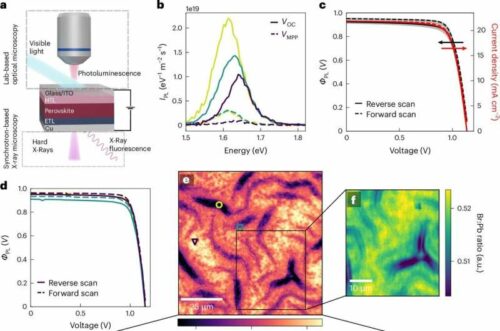Researchers from the University of Cambridge and others have used optical and X-ray microscopy to study nanoscale processes in halide perovskite solar cells.

Perovskites are materials with exceptional optoelectronic properties, offering the potential for more affordable photovoltaic (PV) technologies. Although recent advancements have significantly enhanced the power-conversion efficiency of perovskite solar cells, these devices still face challenges in stability and scalability compared to traditional silicon-based solar cells.
Researchers from the University of Cambridge, Helmholtz-Zentrum Berlin für Materialien und Energie GmbH, and Diamond Light Source have utilized optical and X-ray microscopy to investigate nanoscale processes affecting the performance and degradation of halide perovskite-based solar cells.
The study reveals that microscale variations in composition, recombination, and charge transport play a critical role in determining the performance and stability of these solar cells. The paper also proposes strategies to address these issues, paving the way for more durable and efficient perovskite-based devices.
Fully perovskite-based solar cells consist of more than just a perovskite film; they also include additional layers designed to extract and transport electrons and holes. These extra layers introduce complexity to the cell structure and can contribute to current and voltage losses, ultimately reducing the solar cell’s overall performance.
A research team has developed a microscopy toolkit to analyze perovskite solar cells closely in recent studies. This toolkit incorporates various techniques, which can be broadly classified into optical microscopy and X-ray microscopy methods.
Stranks and his colleagues utilize nano X-ray fluorescence as their primary X-ray microscopy technique, an imaging method that provides detailed insights into materials’ chemical composition.
Using their extensive microscopy toolkit, the team examined various perovskite solar cells. This approach enabled them to understand better how chemical changes influence current and voltage losses and to observe how critical parameters evolved after prolonged operation of the cells.
The researchers not only identified nanoscale factors affecting the performance and stability of perovskite-based solar cells but also proposed strategies to mitigate the current losses observed. Moving forward, the team plans to enhance their microscopy toolkit further and apply it to optimize the long-term performance of perovskite photovoltaics.
Reference: Kyle Frohna et al, The impact of interfacial quality and nanoscale performance disorder on the stability of alloyed perovskite solar cells, Nature Energy (2024). DOI: 10.1038/s41560-024-01660-1.








